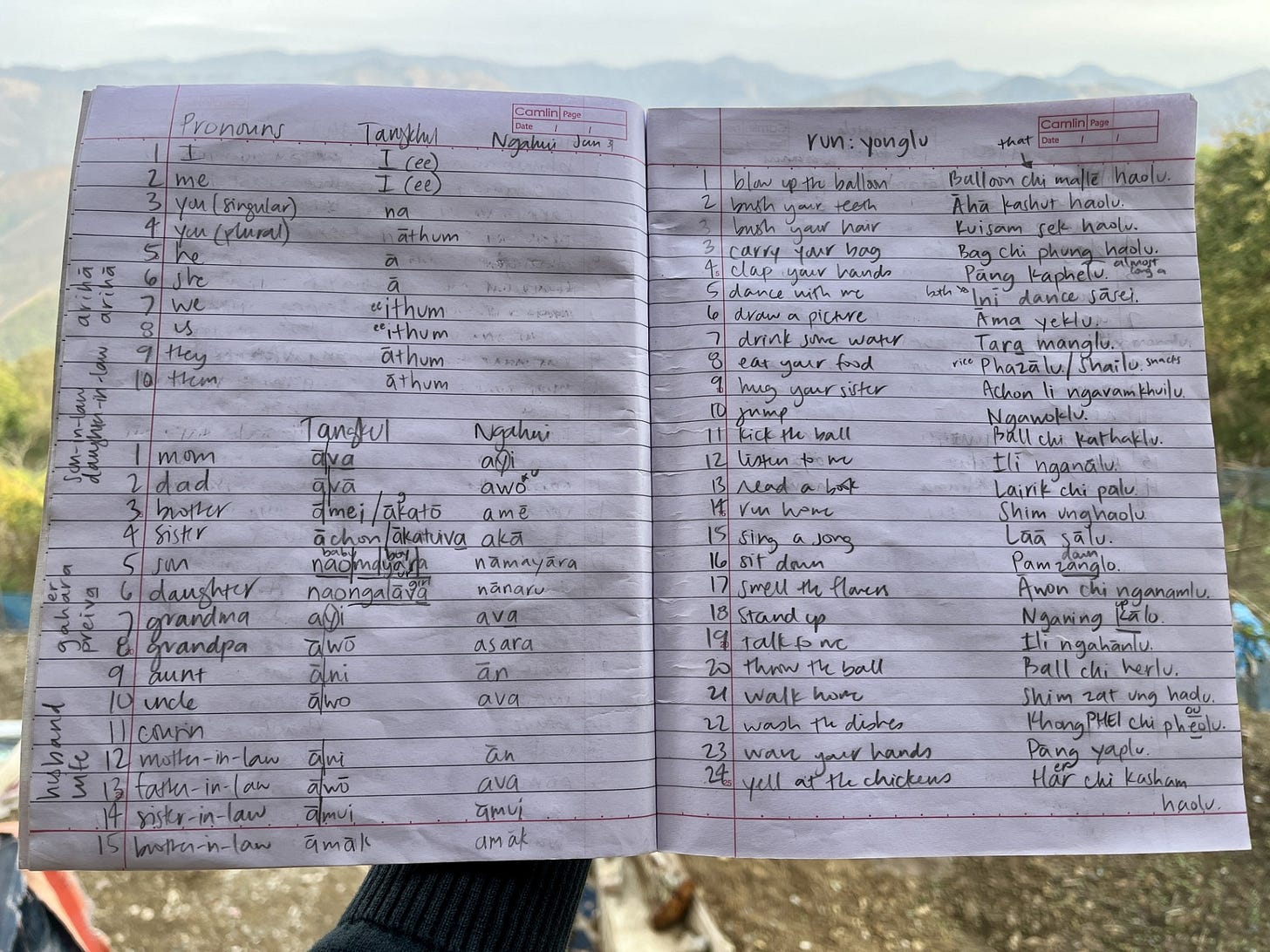I still remember some of the Fijian I learned when I was in high school. O cei na yacamu? What is your name? O yabaki vica? How old are you?
I still speak Thai to my husband — short phrases and simple questions — because it’s often quicker than speaking English.
Fijian and Thai make sense to me. The sentence structure, the sounds of the letters, the patterns.
I wish I could say the same for Tangkhul.
I thought learning Tangkhul would be easy. I thought I would be excited to learn, and I was, I think, at the beginning. I made lists of words — nature words, parts of the body, verbs — and my sister-in-law started to teach me. Our classes are very informal and are usually held when my nephew and sometimes my niece are taking their morning naps.
Maybe that’s the problem. No real structure and no accountability. Maybe it’s because we’re not planning to live here long-term. Maybe it’s because I’m older now.
Or maybe it’s because Tangkhul is stinking hard.
Let me give you some examples.
After a class on verbs (a list of 24, which mostly start with k or kh), I asked my sister-in-law to translate some verb phrases (commands) for me so I could understand the structure of that kind of phrase. “Brush” is kakashut, so I thought “Brush your teeth” would include that word, as one might think, and it does, but you have to take off the first ka. So “Brush your teeth” is Aha kashut haolu. Similarly, “draw” is khayek, while “Draw a picture” is Ama yeklu.
Then there are Tangkhul’s three a’s. The first a is a short u, like the u in bug. In writing, this a is unmarked, meaning that there’s no mark above or below it. The second a is a short o, like the o in hot. When written, it’s given a line on top, like this: ā. The third a is a sound we don’t have in English. It’s almost like the oo in zoo, but it comes more from the back of the throat. In writing, it looks like this: a̲. Tangkhul uses a lot of a’s, so this is always something that makes me have to stop and think. (I guess I should maybe mention here that the English letter a actually makes four sounds…)
There are also a couple of tricky letter sounds, some of which are actually the same in Thai, but I learned (some) Thai by listening, not by looking at the words written with English letters. On the top of almost every page of my Tangkhul notebook, I write, kh = k and k = g. I also need to remember that ph says p and p says b (to my ear).
Enough complaining. I thought learning this language was going to be easy, it’s not, and I don’t feel very motivated. Let’s move on to a few interesting things about the language.
Tangkhul was first written down by Scottish missionary William Pettigrew. (Fijian was also first recorded in writing by a Scottish missionary.) Pettigrew came to Manipur in 1894 and introduced the hill tribes to the gospel. He published a Tangkhul Naga grammar and dictionary in 1918.
I hear quite a few English words when I hear people speaking Tangkhul. Words like program, church, the days of the week, table, long pants (meaning pants), socks, etc. I also hear some Hindi, like aloo for “potato,” as well as some Manipuri, like morah for “stool.”This coupled with the few words I have already memorized gives me a very good chance that I’ll have an idea of what people are talking about.
I’ve happily discovered some patterns in Tangkhul. I am always looking for patterns in languages. Here’s what I’ve found so far.
Ngator, ngashun, ngazin, ngaya: morning, afternoon, evening, night
I is “I” and “me.” Na is “you” (singular). A is “he” and “she.” Add wui to each of these and you get the possessive. Iwui is “my,” nawui is “your” and awui is “his” and “her.”
Sa is “meat.” Add sa to har (chicken, the animal) and you get harsa. Add sa to hok (pig) and you get hoksa. Add sa to sei (buffalo) and you get seisa.
Before leaving Bangkok, I imagined moving to the village and quickly becoming fluent in Tangkhul, but now, I don’t think that’s going to happen. Also, I don’t think that comparing Tangkhul to Fijian and Thai (languages I really love) is going to help me at all. Worchihan’s parents and most of his aunts and uncles don’t speak English, so I do need to learn as much as I can. But I haven’t gotten to the best yet part. While everyone in the village can speak Tangkhul, they actually speak the village’s Tangkhul dialect, meaning I have 2 languages to learn. Sometimes the words are the same, sometimes the words are similar and sometimes they’re totally different. Wish me luck!







Yikes, hang in there Susan :)